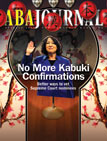This month’s American Bar Association Journal features a cover story on the Supreme Court nomination process called “No More Kabuki Confirmations,” complete with a backdrop of paper lanterns, cherry blossoms and ukiyo-e figures.
It’s a “Kabuki dance,” said Joe Biden when he was a senator on the Judiciary Committee. U.S. Supreme Court nominees give the illusion of responding to senators’ questions, but say little of importance.
… Biden’s successor, Sen. Ted Kaufman, told the National Law Journal that the process resembled the Super Bowl—with press coverage all around.
It’s “a subtle minuet,” said Sen. Arlen Specter during the hearing for Justice Samuel A. Alito Jr., “with the nominee answering as many questions as he thinks are necessary in order to be confirmed.”
For his part, Justice Felix Frankfurter, plagued during his confirmation hearing with suggestions that he was partial to communists, favored the athletic comparison. “I thought that it would just be a little room where we would sit around,” he said of the Judiciary Committee hearing. “I found that this was Madison Square Garden.”
Whether likened to theater, dance or a sporting event, the confirmation process for the Supreme Court has become a set piece of punch and counterpunch, with enough irritation left from one process to undermine the next.
A kabuki minuet in Madison Square Garden would be pretty awesome, but probably not all that similar to the Sotomayor hearings.

 It’s a “Kabuki dance,” said Joe Biden when he was a senator on the Judiciary Committee. U.S. Supreme Court nominees give the illusion of responding to senators’ questions, but say little of importance.
It’s a “Kabuki dance,” said Joe Biden when he was a senator on the Judiciary Committee. U.S. Supreme Court nominees give the illusion of responding to senators’ questions, but say little of importance.
http://www.animenewsnetwork.com/news/2009-10-12/ex-prime-minister-koizumi-to-voice-ultraman-role
Well, to be fair, they’re only calling it “kabuki” as Biden did, and are directly referencing his quote.
The article explains the meaning of “to bork”, and here I was thinking the word only dealt with utterances out of the mouth of the Swedish Chef…
Man, every time a political reporter in the US calls something kabuki, you write an article to call them on it. It’s like some sort of traditional, extravagantly theatrical popular entertainment closely linked to an earlier incarnation of the modern city, scooped up into the high art category and fossilized when the right combination of money and interests occurred, and now considered mainly a fussy set of rules and self-referential gestures or something.
The article isn’t bad, but the cover is ridiculous. I’ll scan it tomorrow.
What really gets me is that the way kabuki is habitually used as a metaphor would actually make more sense with Noh theatre. Have you ever read the stage directions for one of those? It’s nuts.
These days, I think that American politics is more like Kyogen.
猿楽?
That archaic-feeling cover design does hearken to my fond memories of many english-language versions of Japanese web sites, or more recently, Kamei Shizuka’s personal homepage.
狂言, but 猿楽 seems more appropriate.
More like bunraku, really: Puppets manipulated through carefully-defined emotional patterns so skillfully that you almost believe they have agency.
I was gonna say bunraku, but Matt beat me to it!
Fun story: I took a class on Noh while studying in Kyoto, and one day the teacher took us to an actual Noh performance. There were several Japanese people in the audience who were quite obviously sleeping through the whole thing.
Sure, bunraku might fit better as an actual THING, but how can you beat sarugaku for a descriptive name?
OK, here’s the scan.